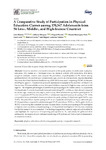Mostrar o rexistro simple do ítem
A Comparative Study of Participation in Physical Education Classes among 170,347 Adolescents from 54 Low-, Middle-, and High-Income Countries
| dc.contributor.author | Martins, João | |
| dc.contributor.author | Marques, Adilson | |
| dc.contributor.author | Peralta, Miguel | |
| dc.contributor.author | Henriques-Neto, Duarte | |
| dc.contributor.author | Costa, João | |
| dc.contributor.author | Onofre, Marcos | |
| dc.contributor.author | González Valeiro, Miguel | |
| dc.date.accessioned | 2020-11-24T18:16:15Z | |
| dc.date.available | 2020-11-24T18:16:15Z | |
| dc.date.issued | 2020-08-02 | |
| dc.identifier.citation | Martins, J.; Marques, A.; Peralta, M.; Henriques-Neto, D.; Costa, J.; Onofre, M.; González Valeiro, M. A Comparative Study of Participation in Physical Education Classes among 170,347 Adolescents from 54 Low-, Middle-, and High-Income Countries. Int. J. Environ. Res. Public Health 2020, 17, 5579. https://doi.org/10.3390/ijerph17155579 | es_ES |
| dc.identifier.issn | 1660-4601 | |
| dc.identifier.uri | http://hdl.handle.net/2183/26766 | |
| dc.description.abstract | [Abstract] Given the need for comparative research on the participation of adolescents in physical education (PE) classes as a privileged space for physical activity (PA) promotion, this study sought to estimate, analyse and compare the prevalence of participation in PE classes among adolescents from 54 countries and to examine sex, age, country income and world regions disparities. Data from the Global Students Health Survey (2010–2015) were used, comprising 170,347 adolescents (90,305 girls, aged 13–17 years) from nationally representative samples of 54 countries—of which 7 are low-income, 23 lower-middle-income, 14 upper-middle-income and 10 high-income—and six world regions. The weighted percentages of adolescents participating in PE classes (never, 1–2 days/week, 3–4 days/week, 5 or more days/week) were estimated along 95% confidence intervals and compared across sex, age, country income, region, and country. Most adolescents reported to participate in PE on 1–2 days/week (55.2%), but almost 20% of adolescents reported never participating in PE. Girls, compared to boys, presented a lower prevalence for participating _5 days/week (girls 16.8%, boys 20.0%). The prevalence of participating in PE on _3 days/week was higher among adolescents aged 13–14 years when compared to adolescents aged 15–17 years (boys: 30.9% vs. 24.6%; girls: 26.1% vs. 18.2%). Concerning the countries’ income, the prevalence of never participating in PE was higher in high-income countries, and participating on _3 days/week was higher in low-income countries, but further research is recommended. The findings suggest that national, regional and worldwide data highlight the importance of improving participation in PE, particularly for girls and older adolescents. An improved and continued monitoring of PE policies and their actual implementation is needed worldwide. | es_ES |
| dc.language.iso | eng | es_ES |
| dc.publisher | MDPI AG | es_ES |
| dc.relation.uri | https://doi.org/10.3390/ijerph17155579 | es_ES |
| dc.rights | Atribución 4.0 Internacional (CC BY 4.0) | es_ES |
| dc.rights.uri | https://creativecommons.org/licenses/by/4.0/ | * |
| dc.subject | Physical education | es_ES |
| dc.subject | School | es_ES |
| dc.subject | Young people | es_ES |
| dc.subject | Survey | es_ES |
| dc.subject | Comparative research | es_ES |
| dc.subject | Educación física | es_ES |
| dc.subject | Escola | es_ES |
| dc.subject | Mozos | es_ES |
| dc.subject | Enquisa | es_ES |
| dc.subject | Investigación comparativa | es_ES |
| dc.subject | Escuela | es_ES |
| dc.subject | Jóvenes | es_ES |
| dc.subject | Encuesta | es_ES |
| dc.title | A Comparative Study of Participation in Physical Education Classes among 170,347 Adolescents from 54 Low-, Middle-, and High-Income Countries | es_ES |
| dc.type | info:eu-repo/semantics/article | es_ES |
| dc.rights.access | info:eu-repo/semantics/openAccess | es_ES |
| UDC.journalTitle | International Journal of Environmental Research and Public Health | es_ES |
| UDC.volume | 7 | es_ES |
| dc.identifier.doi | 10.3390/ijerph17155579 |
Ficheiros no ítem
Este ítem aparece na(s) seguinte(s) colección(s)
-
GI-ESAFEX - Artigos [38]






